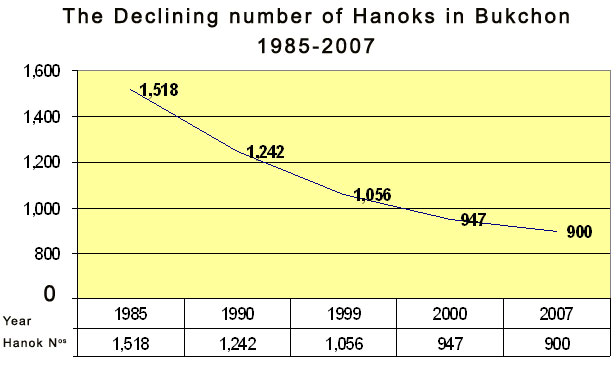Decades of government neglect, failed policies, incompetence, and illegal construction have steadily destroyed Seoul's hanok heritage.
한국어 번역 - 클릭

The Seoul
Metropolitan Government claims it has policies in place to preserve
the hanoks of Bukchon. However, preservation is not just a matter
of having policies. It also requires laws and regulations which need to be
actively enforced to ensure that policy becomes reality.
The simple fact is that for all kinds of reasons, officials at City
Hall, and their advisory bodies keep sanctioning
exceptions to these policies. The cumulative effect of these is an
endless nibbling away at the character of Bukchon and a continuing
decline in the number of hanoks.
Consider the following:
In 1985, when Hanok District City Plan [한옥지구 도시설계 (1985)] was
established, there were 2,756 buildings in Bukchon of which 1,518 (55.1%)
were hanoks.
However, 5 years later, in 1990 according research for the 'Traditional Cultural Site Restoration Plan' [ 전통문화지대 원정비.실시계획 (1990) ], the number of Hanoks had dropped to 1,242 (53,5% of a total of 2,322 buildings in Bukchon).
By 1999, following this had fallen to 1,056 (46.0% of 2,297 Bukchon buildings) [종로구 건축과 자료].
According to the Seoul Development Institute [ 시정연 조사(2000.2) ] , at February 2000, the number of Hanok had dropped to 947 (41% of total Bukchon building numbers). Or only 63% of the number of Hanoks in 1985
Our own estimates
suggested that by the end of 2007, the number of traditional hanoks was no higher than
900. Even today [July 2010] demolitions reduce the number still further.
Some specific examples:
For example, the whole of Kahoi-dong 1 district was demolished to
make way for luxury villas built by the Hanwha Group. This single project erased 88 hanoks.
And, as part of the Bukchon Restoration Plan, Most of the hanoks in my own part of Kahoi-dong - Kahoi-dong 31 – have been demolished and replaced by two story modern concrete buildings with hanok-style roofs. Kahoi-Dong 31 is graded as an SI Preservation Area and, according to the government’s own reports, had the highest concentration of hanoks in the whole of Bukchon as of 2001, and nearly all of these were in good or excellent condition.
The number of hanoks today is 40% less than in 1985. Today, among all the buildings in Bukcheon, Hanoks are now a minority, amounting to less than 40% of the total number of buildings, compared with over 55% in 1985.
The Seoul Metropolitan Government is directly responsible for a
40% reduction in the number of hanoks in Bukchon during the period
they have officially had preservation policies! On
the government’s
own figures, their preservation policy is an abject and total failure,
and has been ever since the formation of the Republic of Korea..
See also: What has the Bukchon
Plan achieved?
![]()